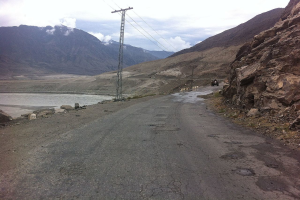Summary
First proposed in 1980, the Diamer-Bhasha Dam has failed to see the day of light in the last 40 years. Pakistan has now inked a deal with a Chinese state-run firm to build the dam. However, it faces several challenges.
On 13 May 2020, Pakistan signed a deal worth PKR442 billion (S$3.7 billion) with the Chinese state-run firm China Power to build the 272-metre high Diamer-Bhasha Dam. The total cost of the project was pegged at around PKR1.497 trillion (S$12.15 billion), which is significantly higher than the earlier estimate of US$14 billion (S$19 billion). The Diamer-Bhasha Dam will be constructed on River Indus in Gilgit-Baltistan and Khyber Pakhtunkhwa. Under the terms of deal, China Power will hold 70 per cent of share while the remaining 30 per cent will be with Frontier Works Organisation, a commercial arm of the Pakistan Armed Forces. This contract covers the construction of a diversion system, main dam, an access bridge and a 21 megawatts Tangir hydropower project. The dam is expected to be completed by March 2028.
At the start of construction, this project is expected to create about 16,500 jobs. Once in operation, it will irrigate around 1.23 million acres of agriculture land and generate 18.1 billion units of electricity annually. The Diamer-Bhasha dam will have gross water storage capacity of 8.1 million acre feet (MAF) and usable storage capacity of 6.4 MAF.
The Diamer-Bhasha Dam project was first suggested in 1980. In 1984, Montreal Engineers Company Ltd carried out feasibility study and identified Bhasha as the dam site. In 1988, this report was reviewed by a panel of experts set up by the Water and Power Development Authority (WAPDA). Ten years later, in 1998, the project was first inaugurated by then Pakistan Prime Minister Nawaz Sharif. In 2006, to generate hydropower and for irrigation purposes, then Pakistan President General Pervez Musharraf decided to construct five multi-purpose projects, including the Diamer-Bhasha Dam, in phases.
Pakistan sought US$ 5billion (S$6.9 billion) from the World Bank to fund the Diamer-Bhasha Dam. It also approached the Asian Development Bank (ADB) which, in principle, agreed but set a pre-condition – Pakistan should develop a national consensus over the project. The ADB’s pre-condition was institutionally fulfilled, as, in July 2010, the Council of Common Interest approved the project. However, in 2012, both the international finance institutions withdrew their support, largely due to India’s opposition to what is located in “illegally occupied territory” by Pakistan. In 2013, the Diamer-Bhasha project was put forward again and, in 2014, the ADB said that it would help the construction of the project to “the extent possible”. However, in 2016, the ADB again declined to fund the project.
In 2016, the Diamer-Bhasha Dam was included in the ‘Indus Cascade’ which China had promised to build under the China Pakistan Economic Corridor (CPEC) framework. A year later, Pakistan removed the dam from the CPEC arrangement due to stringent conditions laid down by China. Pakistan felt that these conditions were against its interests and, hence, not “doable”. Instead of looking for funders, in 2018, Pakistan decided to crowd-fund the dam project, along with the Mohmand Dam. The initiative found overwhelming political support but, in terms of collection, by December 2019, only PKR11.75 billion (S$9.97 million) were collected. Pakistan’s precarious financial condition and insufficient collection of money could have probably led to a re-negotiation of the deal with China.
As in the past, India lodged its “protest and shared concerns with both China and Pakistan on all such projects in the Indian territories under Pakistan’s illegal occupation”. In response, China stated that its cooperation with Pakistan aims to “boost local economic growth and improve people’s livelihoods for the benefit of all”.
Due to the Diamer-Bhasha Dam’s impact on lower stream, in Sindh, a number of political workers, Sindhi nationalists, water experts and others have questioned the “feasibility, tenability and profitability of the dam”.
In Gilgit-Baltistan, many people believe that most of the infrastructure benefits have been given to Bhasha in Khyber Pakhtunkhwa, while the water runs through Diamer. Despite the changes in the Gilgit-Baltistan Order 2018 in which powers over the mineral, hydropower and tourism sectors have been shifted to the legislative assembly of Gilgit-Baltistan, the federal government continues to enjoy unfettered rights over the region’s affairs.
There are issues of financial compensation and royalty for Gilgit-Baltistan. In 2019, the Diamer-Bhasha Dam Affectees Action Committee held a protest in Rawalpindi seeking compensation for their land acquired to build the project. However, information available on WAPDA’s website says that PKR31,063 million (S$263 million) have been released for compensation payment to the affected persons in Gilgit-Baltistan.
The Diamer-Bhasha Dam has common problems which big dams create. First, in their research work published in Energy Policy in 2014, a group of researchers from Oxford University concluded that mega-dams “don’t make economic sense”. Their study singled out the Diamer-Bhasha Dam as a case for “potential cost and construction overruns”. Second, it could flood 100 kilometres of the Karakoram highway, damage villages and about 35,000 people could be displaced. Third, once completed, the Diamer-Bhasha Dam is expected to cause water shortage in the Indian Union Territory of Ladakh. Fourth, it will also affect thousands of 50,000-year old rock carvings in the region. Finally, such investments in Pakistan’s hydropower sector will further push the country into huge hydro debt and make it even more vulnerable to interference and influence by foreign countries.
. . . . .
Dr Amit Ranjan is Research Fellow at the Institute of South Asian Studies (ISAS), an autonomous research institute at the National University of Singapore (NUS). He can be contacted at isasar@nus.edu.sg. The author bears full responsibility for the facts cited and opinions expressed in this paper.
Photo credits: Wikimedia Commons
-
 More From :
More From :
-
 Tags :
Tags :
-
 Download PDF
Download PDF



